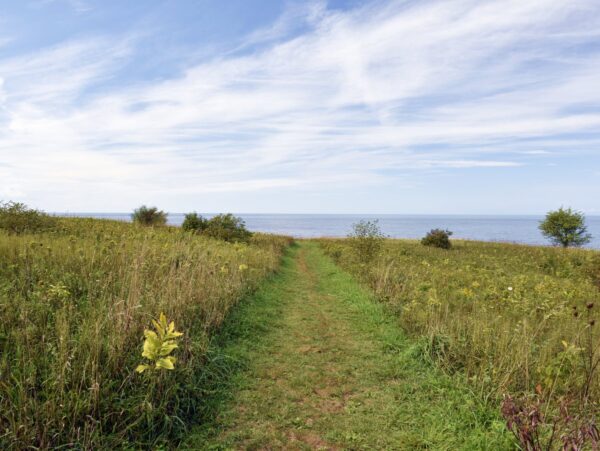When people mention the Town of Sterling in Upstate New York, the Renaissance Festival is likely the first place to come to mind. But only a few miles down the road lies the 1,150-acre Sterling Nature Center, a true gem for hikers, birders, and outdoor enthusiasts. Open dawn to dusk every day, the nature center has a bit of something for all: 8.5 miles of hiking trails, access to paddle on Lake Ontario and Sterling Creek, bluffs, ocean-like views, a beaver pond, vernal pools, roughly 2 miles of pebble beaches, and birding opportunities that will thrill novices and veterans alike. Each season has a new perspective and sights to see, but whenever you choose to visit, bring binoculars.
The trail network has a variety of interconnected loops and spurs that traverse many niches. By combining the loops, you can create an excursion as short as a half-mile or one that explores the entire network. The trails can be divided into three categories: lakeside trails (Bluff, Lake, Lakeview, Eagle View), the woodland trails north of the center (Vernal Pool, Two-tail, Heron, Dogwood Extension), and the marsh/open field trails south of the center (Meadow Loop, Forest Ecology, Buttonbush, Upland Path). There isn’t much elevation gain and trails are decently marked. With all the options and connections, hikers will want to grab a trail map before exploring.
The shoreline trails feature shady canopies, open pebble beaches, bluffs, and dramatic views of Lake Ontario. The smallest of the Great Lakes, Lake Ontario is a phenomenon on its own (see Cornwall Preserve for some of these interesting facts) and its eastern shore faces the prevailing wind, adding to the ocean-like feel.
The southern trails explore more shoreline, wetlands, forest edge habitat, and open meadows. These edge habitats are some of the best places for biodiversity and provide excellent opportunities for wildlife viewing at dawn and dusk. These trails connect with some of the most dramatic views from lakeside trails, notably McIntyre Bluff along the Eagle’s View Trail. Like other bluff trails in the region, the landscape is constantly eroding and changing, so be alert, especially near edges that may be undercut.
The northern woodland trails delve into forests, alongside creeks and vernal pools, and surround one of the center’s main attractions, the 80-acre Beaver Wetland. The wetland provides an interesting perspective on North America’s busiest keystone species, the beaver. Keystone species are animals that shape and maintain the landscape that other species depend on. Beavers remove trees and create openings for understory and shade-intolerant plants to grow. Their dams create wetlands that support a wide variety of aquatic animal species. For example, the trees caught within the new wetland soon die off, but in turn, they provide roosts. The beaver’s role is one of disrupter and catalyst but also steward. Without the keystone species, the habitats and accompanying biodiversity collapse. Indeed, the wetland and accompanying rookery were at risk of disappearing in 2013 when heavy rains and flooding destroyed the existing dam. But the beavers rebuilt the dam within months, reaffirming their role as preeminent hydraulic engineers and caretakers.
The northern woodland trails do not encircle the wetland but rather explore the surrounding landscape with spur trails that lead to lookouts, each with impressive views and amazing birdwatching. The “rookery” is part of the Beaver Wetland with a plethora of standing dead trees, dozens of which support large nests. The heron rookery is most active from mid-May through late June/early July, but birding here (and around the whole nature center) is excellent year-round, whether it’s during nesting season, migration seasons, or even during winter when owls can often be seen. It is a perfect opportunity to spot Harriers, Osprey, Great Horned Owls, Bald Eagles, and Heron. Great Blue Heron stand four feet tall and with wing spans close to six feet, so it’s easy to see why they draw so many onlookers. But birding is not limited to just the birds of prey. The diversity of habitats favors waterfowl, woodland, meadow, wetland, and cliff-dwelling species as well. Birders often sight dozens of species in a single visit, ample reason to pack a pair of binoculars for your visit.
The center is a favorite for hikers and birders, but paddlers will also find great reasons to visit. With a short portage to the beach, you can launch into Lake Ontario directly. Or use the small boat launch off Farden Road and take a 5.5-mile trip down Sterling Creek to Sterling Pond at Fair Haven Beach State Park.
In winter, cross-country skiing and snowshoeing are prime reasons to visit, and in all seasons, there are educational and nature-focused activities (with the promise of even more to come when the new facilities open). Over the past couple of years, the Sterling Nature Center has undergone a major transformation. The facilities used to reside within the original property owner’s home. But in 2024, a 5,000-square-foot interpretive building opened to the public, and houses educational programs, exhibits, events, and more.















